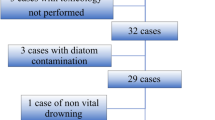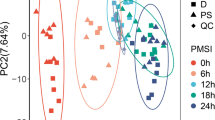Abstract
Drowning is a common cause of accidental death worldwide, and it continues to be a serious public health problem. However, diagnosing drowning is a challenging task in forensic investigation because it is difficult to prove actual drowning and other submerged deaths with the autopsy techniques that are currently in use. Here, we show biomarkers that may be helpful for the diagnosis of drowning. We divided the experimental animals into four groups (drowning, postmortem submersion, hypoxia, and control) to evaluate the expression patterns of extracellular signal-regulated kinase 1/2 (ERK1/2). On gene expression analysis, only ERK2 was found to be significantly increased in the drowning groups compared to the other cases. In the immunoblot analysis, phosphorylated ERK2 (p-ERK2) was found to be upregulated in the drowning groups. Immunohistochemical staining also showed that p-ERK in alveolar cells revealed a granular pattern in the drowning groups. However, the expression pattern of ERK2 over time after drowning differed between the freshwater and seawater drowning groups. Taken together, these results indicate that ERK2 may be useful for distinguishing between drowning and postmortem submersion if the postmortem interval (PMI) of drowning is short. Conversely, if the PMI is long from the time that death occurs until the discovery of dead bodies, it is possibly more helpful for identifying between freshwater and seawater drowning.




Similar content being viewed by others
References
Jin F, Li C (2017) Seawater-drowning-induced acute lung injury: From molecular mechanisms to potential treatments. Exp Ther Med 13:2591–2598. https://doi.org/10.3892/etm.2017.4302
Kringsholm B, Filskov A, Kock K (1991) Autopsied cases of drowning in Denmark 1987–1989. Forensic Sci Int 52:85–92. https://doi.org/10.1016/0379-0738(91)90099-5
Levin DL, Morriss FC, Toro LO, Brink LW, Turner GR (1993) Drowning and near-drowning. Pediatr Clin North Am 40:321–336. https://doi.org/10.1016/S0031-3955(16)38513-3
Wirthwein DP, Barnard JJ, Prahlow JA (2002) Suicide by drowning: a 20-year review. J Forensic Sci 47:131–136. https://doi.org/10.1520/JFS15213J
Peden MM, McGee K (2003) The epidemiology of drowning worldwide. Inj Control Saf Promot 10:195–199. https://doi.org/10.1076/icsp.10.4.195.16772
Lunetta P, Smith GS, Penttilä A, Sajantila A (2004) Unintentional drowning in Finland 1970–2000: a population-based study. Int J Epidemiol 33:1053–1063. https://doi.org/10.1093/ije/dyh194
Somers GR, Chiasson DA, Smith CR (2005) Pediatric drowning: a 20-year review of autopsied cases: I. Demographic features. Am J Forensic Med Pathol 26:316–319. https://doi.org/10.1097/01.paf.0000188094.09946.05
Somers GR, Chiasson DA, Smith CR (2006) Pediatric drowning: a 20-year review of autopsied cases: II. Pathologic features. Am J Forensic Med Pathol 27:20–24. https://doi.org/10.1097/01.paf.0000201103.67465.6a
Organization WH (2014) Global report on drowning: preventing a leading killer. World Health Organization
Tyler MD, Richards DB, Reske-Nielsen C et al (2017) The epidemiology of drowning in low-and middle-income countries: a systematic review. BMC Public Health 17:1–7. https://doi.org/10.1186/s12889-017-4239-2
Abelairas-Gomez C, Tipton MJ, González-Salvado V, Bierens JJ (2019) Drowning: epidemiology, prevention, pathophysiology, resuscitation, and hospital treatment. Emergencias: Revista de la Sociedad Espanola de Medicina de Emergencias 31:270–280. https://doi.org/10.3390/medicina56110577
Real ÁD, Sanchez-Lorenzo A, Lopez-Bustins J, Zarrabeitia M, Santurtún A (2021) Atmospheric circulation and mortality by unintentional drowning in Spain: from 1999 to 2018. Perspect Public Health:17579139211007181. https://doi.org/10.1177/17579139211007181
Girela-López E, Beltran-Aroca CM, Dye A, Gill JR (2022) Epidemiology and autopsy findings of 500 drowning deaths. Forensic Sci Int 330:111137. https://doi.org/10.1016/j.forsciint.2021.111137
van Beeck EF, Branche CM, Szpilman D, Modell JH, Bierens JJ (2005) A new definition of drowning: towards documentation and prevention of a global public health problem. Bull World Health Organ 83:853–856
Armstrong EJ, Erskine KL (2018) Investigation of Drowning Deaths: A Practical Review. Acad Forensic Pathol 8:8–43. https://doi.org/10.23907/2018.002
Wyatt JP, Squires T, Norfolk G, Payne-James J (2011) Oxford handbook of forensic medicine. Oxford University Press
Saukko P, Knight B (2015) Knight's forensic pathology. CRC press
Brinkmann B (2004) Tod im wasser Handbuch gerichtliche medizin, vol 1, pp 797–819. https://doi.org/10.1007/s00194-003-0212-8
Piette MH, De Letter EA (2006) Drowning: still a difficult autopsy diagnosis. Forensic Sci Int 163:1–9. https://doi.org/10.1016/j.forsciint.2004.10.027
Hayashi T, Ishida Y, Mizunuma S, Kimura A, Kondo T (2009) Differential diagnosis between freshwater drowning and saltwater drowning based on intrapulmonary aquaporin-5 expression. Int J Leg Med 123:7–13. https://doi.org/10.1007/s00414-008-0235-5
Morild I (1995) Pleural effusion in drowning. Am J Forensic Med Pathol 16:253–256. https://doi.org/10.1097/00000433-199509000-00014
Zhu BL, Quan L, Li DR et al (2003) Postmortem lung weight in drownings: a comparison with acute asphyxiation and cardiac death. Leg Med 5:20–26. https://doi.org/10.1016/S1344-6223(02)00172-4
Reidbord HE, Spitz WU (1966) Ultrastructural alterations in rat lungs. Changes after intratracheal perfusion with freshwater and seawater. Arch Pathol 81:103–111
Nopanitaya W, Gambill TG, Brinkhous KM (1974) Fresh water drowning. Pulmonary ultrastructure and systemic fibrinolysis. Arch Pathol 98:361–366
Brinkmann B, Fechner G, Püschel K (1983) Ultrastructural pathology of the alveolar apparatus in experimental drowning. Z Rechtsmed 91:47–60. https://doi.org/10.1007/BF01882448
Yorulmaz C, Arican N, Afacan I, Dokgoz H, Asirdizer M (2003) Pleural effusion in bodies recovered from water. Forensic Sci Int 136:16–21. https://doi.org/10.1016/S0379-0738(03)00226-3
Barranco R, Castiglioni C, Ventura F, Fracasso T (2019) Immunohistochemical expression of P-selectin, SP-A, HSP70, aquaporin 5, and fibronectin in saltwater drowning and freshwater drowning. Int J Leg Med 133:1461–1467. https://doi.org/10.1007/s00414-019-02105-1
Frisoni P, Diani L, De Simone S, Bosco MA, Cipolloni L, Neri M (2022) Forensic Diagnosis of Freshwater or Saltwater Drowning Using the Marker Aquaporin 5: An Immunohistochemical Study. Medicina 58:1458. https://doi.org/10.3390/medicina58101458
Allam FAFA, Ali DM, Ali SFE-S (2022) Drowning versus postmortem submersion: Biochemical and histopathological examination and estimation of postmortem intervals (an experimental study). Leg Med 59:102138. https://doi.org/10.1016/j.legalmed.2022.102138
Lee SY, Ha EJ, Cho HW, Kim HR, Lee D, Eom YB (2019) Potential forensic application of receptor for advanced glycation end products (RAGE) and aquaporin 5 (AQP5) as novel biomarkers for diagnosis of drowning. J Forensic Leg Med 62:56–62. https://doi.org/10.1016/j.jflm.2019.01.007
Cho HW, Eom YB (2019) Potential forensic application of receptor for advanced glycation end products (RAGE) as a novel biomarker for estimating postmortem interval. J Forensic Sci 64:1878–1883. https://doi.org/10.1111/1556-4029.14063
Busca R, Pouyssegur J, Lenormand P (2016) ERK1 and ERK2 Map Kinases: Specific Roles or Functional Redundancy? Front Cell Dev Biol 4:53. https://doi.org/10.3389/fcell.2016.00053
Hoffert JD, Leitch V, Agre P, King LS (2000) Hypertonic induction of aquaporin-5 expression through an ERK-dependent pathway. J Biol Chem 275:9070–9077. https://doi.org/10.1074/jbc.275.12.9070
Zhang Z, Yang X-Y, Cohen DM (1998) Hypotonicity activates transcription through ERK-dependent and -independent pathways in renal cells. Am J Physiol Cell Physiol 275:C1104–C1C12. https://doi.org/10.1152/ajplung.1998.275.2.L288
Hao YL, Fang HC, Zhao HL et al (2018) The role of microRNA-1 targeting of MAPK3 in myocardial ischemia-reperfusion injury in rats undergoing sevoflurane preconditioning via the PI3K/Akt pathway. Am J Physiol Cell Physiol 315:C380–C3C8. https://doi.org/10.1152/ajpcell.00310.2017
Zarei S, Taghian F, Sharifi G, Abedi H (2022) Novel prevention insights into depletion of oxidative stress status through regular exercise and grape seed effective substance in heart ischemia rat model. Food Sci Nutr 10:833–845. https://doi.org/10.1002/fsn3.2714
Rocha-Martins M, Njaine B, Silveira MS (2012) Avoiding pitfalls of internal controls: validation of reference genes for analysis by qRT-PCR and Western blot throughout rat retinal development. https://doi.org/10.1371/journal.pone.0043028
Storm S, Cleveland J, Rapp U (1990) Expression of raf family proto-oncogenes in normal mouse tissues. Oncogene 5:345–351
Frémin C, Saba-El-Leil MK, Lévesque K, Ang S-L, Meloche S (2015) Functional redundancy of ERK1 and ERK2 MAP kinases during development. Cell Rep 12:913–921. https://doi.org/10.1016/j.celrep.2015.07.011
Christen R, Lovern M, Clifford AM et al (2015) ERK1 and ERK2 present functional redundancy in tetrapods despite higher evolution rate of ERK1. BMC Evol Biol 15:1–15. https://doi.org/10.1186/s12862-015-0450-x
Roskoski R (2012) ERK1/2 MAP kinases: Structure, function, and regulation. Pharmacol Res 66:105–143. https://doi.org/10.1016/j.phrs.2012.04.005
Ishigami A, Kashiwagi M, Ishida Y et al (2021) A comparative study of pleural effusion in water area, water temperature and postmortem interval in forensic autopsy cases of drowning. Sci Rep 11:1–10. https://doi.org/10.1038/s41598-021-01047-2
Borgnia M, Nielsen S, Engel A, Agre P (1999) Cellular and molecular biology of the aquaporin water channels. Annu Rev Biochem 68:425–458. https://doi.org/10.1146/annurev.biochem.68.1.425
Verkman A (2002) Aquaporin water channels and endothelial cell function. J Anat 200:617–627. https://doi.org/10.1046/j.1469-7580.2002.00058.x
King LS, Kozono D, Agre P (2004) From structure to disease: the evolving tale of aquaporin biology. Nat Rev Mol Cell Biol 5:687–698. https://doi.org/10.1038/nrm1469
Li J, Xu M, Fan Q et al (2011) Tanshinone IIA ameliorates seawater exposure-induced lung injury by inhibiting aquaporins (AQP) 1 and AQP5 expression in lung. Respir Physiol Neurobiol 176:39–49. https://doi.org/10.1016/j.resp.2011.01.005
Funding
This study was supported by the Soonchunhyang University Research Fund and a National Research Foundation of Korea (NRF) grant funded by the Korean government (MSIT) [NRF-2023R1A2C1003486].
Author information
Authors and Affiliations
Contributions
All authors contributed to the study conception and design. Material preparation, data collection and analysis were performed by Min-Jeong Kim and Yong-Bin Eom. The first draft of the manuscript was written by Min-Jeong Kim and all authors commented on previous versions of the manuscript. All authors read and approved the final manuscript.
Corresponding author
Ethics declarations
Ethics approval
The study was approved by the Institutional Animal Care and Use Committee of Soonchunhyang University (IACUC approval number: SCH17-0003).
Conflict of Interest
The authors declare no competing interests.
Additional information
Publisher’s note
Springer Nature remains neutral with regard to jurisdictional claims in published maps and institutional affiliations.
Supplementary information

Supplementary Figure 1
Relative expression analysis of AQP5 in 2 h drowning cases (a) and 48 h drowning cases (b) using quantitative real-time PCR. The mean was normalized to the GAPDH reference and expressed as a ratio. Control (CON), freshwater drowning (FD), and seawater drowning (SD). ***p < 0.001 vs. CON. #p < 0.001 vs. SD (PNG 106 kb)
Rights and permissions
Springer Nature or its licensor (e.g. a society or other partner) holds exclusive rights to this article under a publishing agreement with the author(s) or other rightsholder(s); author self-archiving of the accepted manuscript version of this article is solely governed by the terms of such publishing agreement and applicable law.
About this article
Cite this article
Kim, MJ., Eom, YB. Applicable Forensic Biomarker for Drowning Diagnosis: Extracellular Signal-Regulated Kinase 2 (ERK2). Int J Legal Med 137, 1245–1252 (2023). https://doi.org/10.1007/s00414-023-02992-5
Received:
Accepted:
Published:
Issue Date:
DOI: https://doi.org/10.1007/s00414-023-02992-5




